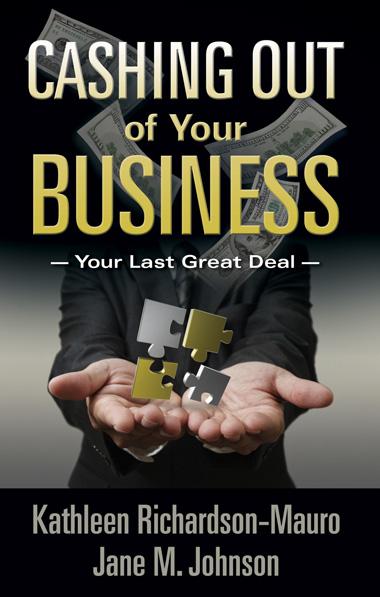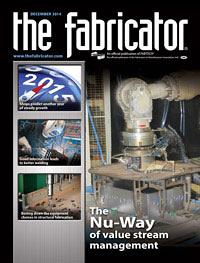Senior Editor
- FMA
- The Fabricator
- FABTECH
- Canadian Metalworking
Categories
- Additive Manufacturing
- Aluminum Welding
- Arc Welding
- Assembly and Joining
- Automation and Robotics
- Bending and Forming
- Consumables
- Cutting and Weld Prep
- Electric Vehicles
- En Español
- Finishing
- Hydroforming
- Laser Cutting
- Laser Welding
- Machining
- Manufacturing Software
- Materials Handling
- Metals/Materials
- Oxyfuel Cutting
- Plasma Cutting
- Power Tools
- Punching and Other Holemaking
- Roll Forming
- Safety
- Sawing
- Shearing
- Shop Management
- Testing and Measuring
- Tube and Pipe Fabrication
- Tube and Pipe Production
- Waterjet Cutting
Industry Directory
Webcasts
Podcasts
FAB 40
Advertise
Subscribe
Account Login
Search
An exit strategy for the metal fabrication job shop owner
For aging shop owners looking for an exit strategy, retiring is personal
- By Tim Heston
- February 3, 2015
- Article
- Shop Management
Demographics and economic circumstances have brought business valuation to the fore in recent years. Baby boomers who launched or inherited fab shops are looking for an exit strategy. Sometimes that involves passing on the torch to the next generation. Sometimes it means selling a business to an external party, be it a strategic (a competing or complementary business) or financial (investor, private equity) buyer.
What’s missing in a lot of the discussion is the human side of the equation. To manage by valuation (whether a sale is imminent or not), owners analyze competitors, the market, and various operational and financial metrics. It’s nothing personal; it’s just business—right?
Thing is, I don’t think that cliché really applies to metal fabrication, and it’s not just because so many fabricators are family enterprises. There’s an engagement among fab shop owners that really stands apart. Granted, I’m generalizing here. Owners who attend tradeshows and conferences and, for that matter, open their company doors to an industry reporter usually aren’t lackadaisical. They have a story to tell, and they’re happy to tell it to a curious listener.
But it’s easy to see why this industry has engaged, passionate owners. Why else would people be in this business?
Steve Wiseman, executive vice president of operations at Des Plaines, Ill.-based Nu-Way Industries, a fabricator featured in this issue, recalled the company’s growth before globalization ramped up in a serious way. “It wasn’t hard to make money in the 1980s.”
Back then you bought a punch press and press brake—both of which had “flexible tooling” so you didn’t have to machine dedicated dies in a stamping press—and work would come in the door. Today everybody has advanced machinery promising ridiculously short cycle times. Just having a laser doesn’t set a shop apart anymore.
Admittedly, this is an oversimplification, and many tend to look at the past through rose-colored glasses. But the current climate isn’t one for any business owner wanting to make a quick buck. Owners must deal with constant pricing pressures and ask hard questions.
Do you grow on the backs of several large accounts, which can bring in money so you can reinvest in the business (especially in productive machinery) and yet can be risky, thanks to highly concentrated revenue sources? Or do you stay small and focus on nonrepeat job shop business that isn’t the easiest to scale up, but perhaps is much easier to diversify? Do you launch a product line? Do you focus on piece-part work, or broaden your services to provide assemblies? Do you bring in powder coating or machining, or continue to partner with area firms?
Asking questions, thinking, staying up nights—owners in this industry become so engaged that in one sense the business becomes part of their identity. When an owner cashes out, what happens to that identity?
Last year Kathleen Richardson-Mauro, whose husband owns a metal manufacturing company, and Jane M. Johnson published Cashing Out of Your Business, a book that tackles not just the nuts and bolts of selling an enterprise—revenue concentration, profitability, health of the market—but also the personal elements. When an owner sells a business, his or her life changes in a dramatic way.
This includes finances for the owners and their family (or families). We’re all taught that, when planning for retirement, we shouldn’t put all of our eggs in one basket. Small-business owners, though, have a different perspective: What could be safer than investing in an asset you can control, like a family business?
But unexpected things happen, of course, and quite often it’s out of the owner’s control. Say an OEM’s purchasing agent gets word from top management that they’re looking for cost reductions, so the purchaser pulls work and sends it to a lower-cost supplier. Never mind that the total cost of ownership is higher, thanks to quality problems and late deliveries. The supplier change gives top managers at the OEM something to put in their quarterly report to investors. This deals a major, perhaps fatal, blow to the fabricator. Employees may have savings in their 401(k)s and IRAs, but how about the owners?
Reinvesting in the business—to buy equipment, hire more, share profits with employees, and expand—is all well and good, but owners should plan for the future as well. As the authors state, “Saving money outside the business provides diversification for you and more choices when it comes time to transition the ownership. For example, owners who have saved a lot may be able to afford to sell the company to family members or key employees who are unable to pay top dollar for the company.” Moreover, if the owner has diversified and saved enough, he or she won’t need to depend on the business for income into their retirement years, and that can be quite a gift for the next generation.
The book also tackles a much more complex topic: personal happiness. Owners who built their business from nothing have an emotional connection. The fab shop is their life’s work, and parting with it isn’t very fun. Richardson-Mauro and Johnson describe one business owner in his mid-50s who was tired of the daily grind, of answering customer calls, of all the worry and exhaustion. He wanted to stop working and start living.
When he sold the business, though, he felt lost, detached, and alone. His close friends were still working, and he frequently stopped by the company to chat and reconnect. As the authors put it, “He was bored. His business was all he knew. He missed the employees, the customers, the challenge, the grind.”
The authors don’t judge him as a workaholic. Sure, he was tired, but he was also happy and engaged. Why step away completely? In this case, he could have not sold the business at all but instead stepped away from the day-to-day duties and focused on the best parts of the job. Of course, such an arrangement might drive another type of owner out of his mind.
There’s no one right way to retire or leave this business. It depends on the numbers, but it also depends on the fab shop owner. The better the numbers are, of course, the more options the owner has.
Kathleen Richardson-Mauro and Jane Johnson are founders of Business Transition Academy, www.businesstransitionacademy.com.
About the Author

Tim Heston
2135 Point Blvd
Elgin, IL 60123
815-381-1314
Tim Heston, The Fabricator's senior editor, has covered the metal fabrication industry since 1998, starting his career at the American Welding Society's Welding Journal. Since then he has covered the full range of metal fabrication processes, from stamping, bending, and cutting to grinding and polishing. He joined The Fabricator's staff in October 2007.
subscribe now

The Fabricator is North America's leading magazine for the metal forming and fabricating industry. The magazine delivers the news, technical articles, and case histories that enable fabricators to do their jobs more efficiently. The Fabricator has served the industry since 1970.
start your free subscription- Stay connected from anywhere

Easily access valuable industry resources now with full access to the digital edition of The Fabricator.

Easily access valuable industry resources now with full access to the digital edition of The Welder.

Easily access valuable industry resources now with full access to the digital edition of The Tube and Pipe Journal.
- Podcasting
- Podcast:
- The Fabricator Podcast
- Published:
- 04/16/2024
- Running Time:
- 63:29
In this episode of The Fabricator Podcast, Caleb Chamberlain, co-founder and CEO of OSH Cut, discusses his company’s...
- Trending Articles
Capturing, recording equipment inspection data for FMEA

Tips for creating sheet metal tubes with perforations

Are two heads better than one in fiber laser cutting?

Supporting the metal fabricating industry through FMA

Hypertherm Associates implements Rapyuta Robotics AMRs in warehouse

- Industry Events
16th Annual Safety Conference
- April 30 - May 1, 2024
- Elgin,
Pipe and Tube Conference
- May 21 - 22, 2024
- Omaha, NE
World-Class Roll Forming Workshop
- June 5 - 6, 2024
- Louisville, KY
Advanced Laser Application Workshop
- June 25 - 27, 2024
- Novi, MI



























